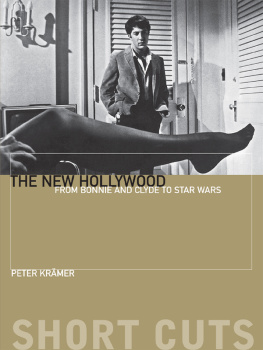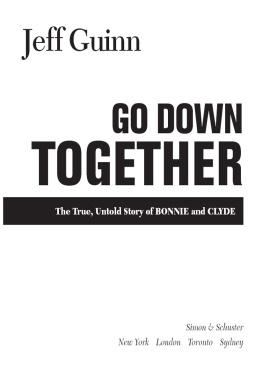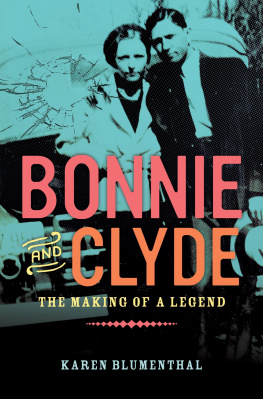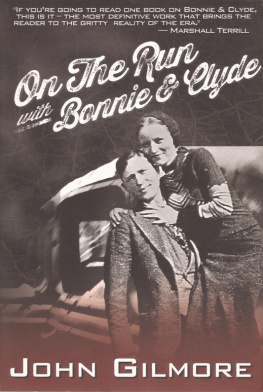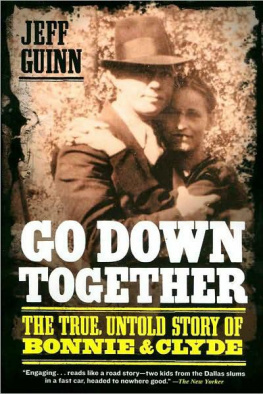All rights in this book are reserved. No part of this book may be used or reproduced in any manner whatsoever without a written request to and response from the publisher, except in the case of brief quotations embodied in a review.
| Copyright 1979 By L. J. Hinton Published By Eakin Press An Imprint of Wild Horse Media Group P.O. Box 331779 Fort Worth, Texas 76163 1-817-344-7036 www.EakinPress.com ALL RIGHTS RESERVED 1 2 3 4 5 6 7 8 9 ISBN-13: 978-1-68179-176-0 |
Library of Congress Cataloging in Publication Data
Hinton, Ted, 19041977.
Ambush : the real story of Bonnie and Clyde.
Includes index.
1. Barrow, Clyde, 19091934. 2. Parker, Bonnie,
19101934. 3. Crime and criminalsTexasBiography.
I. Grove, Larry, 1923 II. Title.
HV6245.H48 364.155 [B] 79-11686
PB ISBN 978-168179-157-9 (previously ISBN 0-88319-041-9 & 0-971523-0-2)
Contents
List of Illustrations
Foreword
Preface
The Life and Death of Bonnie and Clyde by Bonnie Parker
IThe Dirty Thirties
IIAnte Up
IIIMurder Begins
IVNo Turning Back
VThe Hamilton Connection
VIThe Barrow Gang Forms
VIIHell Breaks Out in Platte City
VIIIA Twenty-Acre Battleground
IXA Mystery Solved
XMachine Gun Kelly Was a Piker
XIThe First Ambush
XIIFull Time on a Hard Trail
XIIINear Misses
XIVNew Help for an Old Chore
XVThe Hamilton Split
XVIAmbush: The Real Story
XVIITwo True Lovers
Appendix A: People Killed by the Barrow Gang
Appendix B: Chronology: The Career of Bonnie and Clyde
Index
Illustrations
Bonnie Parker and Clyde Barrow in 1933 .. frontispiece Ted Hinton as a boy
Looking tough in the Dallas of 1922
Ted at age 27
Raymond Hamilton
Snapshots of Bonnie, Clyde, and accomplice W. D. Jones, taken by themselves in 1933
Officers with articles taken from Barrow car
Henry Methvin
Clyde in the death car
Bonnie in the death car
Bullet-ridden car
Searching the death car
Clyde at the undertaker
Bonnie at the undertaker
Clydes bullet-tom coat
Officers with impounded car
The six officers who shot Bonnie and Clyde
Foreword
For many years people were after my father, Ted Hinton, to set things straight about the capture of Bonnie and Clyde. He continually resisted. I believe it was his appointment to the Dallas County Historical Commission that finally prompted Ted to write his book. Until then even I couldnt get him to write it, and I tried hard, because of the difference between the legend about the capture and what he told me to be the actual facts.
Ted had told me of a secret agreement between the six officers involved in the capture. This agreement was that the story would remain as it had been written so long as more than one of the officers was living. When it got down to just one surviving officer, regardless of who it was, that man would have the prerogative of leaving history as it was or of telling the real story. Ted was the last surviving officer.
The fact is, these six officers broke the law to capture Bonnie and Clyde. They didnt intend to, but when the chance came unexpectedly, at 4 A.M. on May 23, 1934, to set a trap, they decided that the opportunity to catch the known killers of twelve people outweighed the violation of rights that occurred on that Louisiana road. The trap worked after two years of intensive police work had failed to stop the killing by Bonnie and Clyde. I leave it to readers who follow their trail with Ted to decide if the officers made the right choice.
Ted saw his job as one that had to be done, and he became fascinated with it, even obsessed by it but he never reduced Clyde and Bonnie to inhuman cases in his mind. He had known the Barrow family when he and Clyde were both growing up in Dallas, and he counted Clydes brothers and parents among his friends. He always admired the guts that made Clyde and Bonnie stand out from the criminals who were such hot copy in the newspapers in the 1930s. The family understood that Ted had to track Clyde down, and in later years Ted helped the family in whatever ways he could.
I knew that Ted was writing a book about his experiences, but I didnt know how it was coming along when he called me on September 23, 1977, and requested that I come over to his place. We discussed some matters that he had going on, and then he dropped his bombshell: he had finished his book.
He handed me the manuscript and all his notes and tapes. At the same time he told me, Here it is, son. Ive finished it, but I wont be able to do anything with it. I told him that we could discuss it further when we went to the D.A.s luncheon the following Monday, but he said, I wont be able to make this one. Ive got something else that has come up that Ive got to do.
I found out what it was that Monday; he had to go into the hospital. Ted died a month later, on October 27, 1977, never having seen his book in print. It stands as his memorial.
L. J. (BOOTS) HINTON
Preface
Forty years and more have passed since Ted Hinton and five other peace officers set up an ambush on a lonely road near Gibsland, Louisiana, and ended the lives of the Southwests most deadly outlaw pair, Bonnie Parker and Clyde Barrow.
In 1977 only Hinton survived of the six officers who were more castigated than praised by many for their trouble. In this book, Hinton tells how it was and why the officers themselves withheld for so many years some facts about the ambush by mutual agreement. Because part of the story was withheld, some of the legends of Bonnie and Clyde were allowed to grow in a direction that was different from the way it was. Hinton, by. the 1970s, saw no harm in setting the record straight for posteritys sake.
Hinton drew not only on newspapers and public records. He kept extensive scrapbooks that preserved letters, check stubs, and many other artifacts from his seventeen-month hunt for Bonnie and Clyde. Mounted in wallpaper catalogs, these records are now on microfilm in the Dallas Public Library. In addition, he kept notebooks full of information about his own personal experience on the trail of the Barrow Gang. And he drew on police sources that were not in the public record to fill in portions of the careers of Bonnie and Clyde. He was a meticulous record keeper he loved to tell stories, but he always insisted that the facts be straight. In this book the wealth of detail about Bonnie and Clyde testifies to his belief in telling a true story exactly the way it happened.



